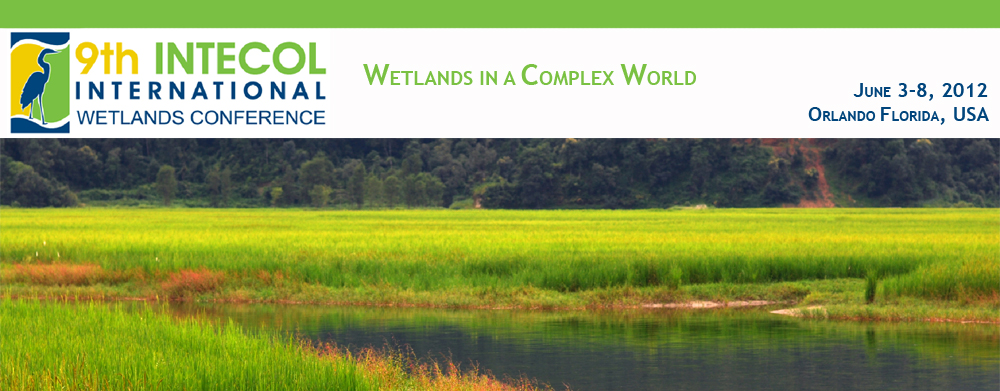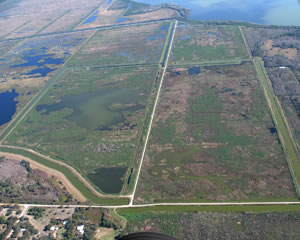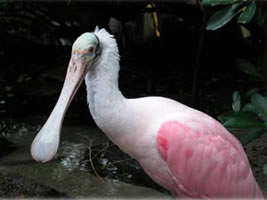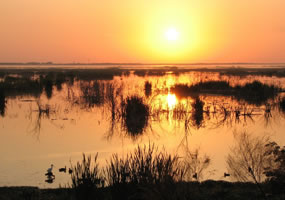

Please note the number of participants individual field trips are limited to is published at the top of each flyer. Field trip seating is very limited therefore participation is restricted to meeting attendees only. Sorry, no guests.
Please note the Technical Training Field Trips will take place in various outdoor locations which involve traversing rugged terrain, canoeing for two hours and visiting Florida’s natural sub-tropical environment. Participants should expect to deal with heat and humidity and the possibility of sunburn, insects and wildlife. Though every reasonable precaution will be taken to prevent injury, in order to participate in a technical field trip, participants must sign a liability waiver accepting full responsibility should they suffer bodily injury or harm. Each field trip flyer will list specific instructions on how to dress, what to bring and what refreshments will be provided.
Cape Canaveral Wetlands (Limited to 20 people)
|
||||
Emeralda Marsh Restoration (Limited to 20 people) Participants will tour portions of the Emeralda Marsh Conservation Area (EMCA), a 2,560 ha area of former agricultural farms. Restoration at this site converted former row-crop farm fields and cattle pastures to wetland and aquatic habitat. In addition, nutrient loading from the former farms to adjacent Lake Griffin was reduced by about 80%. This resulted in substantial water quality improvements in Lake Griffin and the return of submerged aquatic vegetation so important for fish and wildlife habitat. The EMCA has become a major wildlife observation site that is heavily utilized by the public. Emeralda Marsh Conservation Area and the adjoining 3,600 ha Lake Griffin west of Leesburg, FL. have been a focus of restoration efforts by the St. Johns River Water Management District since 1995. The tour will begin at the ‘Wood Duck Parking Area’ at the beginning of the Emeralda Marsh Wildlife Drive. The bus will travel over former agricultural farm levees which have been elevated and stabilized with limerock. The tour will first see a recently established connection from a former farm field and cattle pasture area of about 280 ha to Haynes Creek, the major tributary of Lake Griffin. Next, the tour will stop at an alum treatment system which functions to treat discharges from about 430 ha of former row crop farm fields located on the western portion of the restoration area. Water levels are currently controlled on these sites to encourage wetland vegetation. Because residual nutrient concentrations remain at levels not acceptable for discharge to restored Lake Griffin, all discharges are treated with aluminum sulfate to control phosphorus concentrations. The tour will then travel over these former row-crop farm fields to observe the ongoing restoration to wetland habitat. This will be a prime opportunity to see wildlife. The last stop on the tour will be at the ‘P’ cell retention area and alum treatment system at Emeralda Island Road. This structure provides alum treatment of all water being discharged from about 1,120 ha of restored wetland and aquatic habitat east of Emeralda Island Road. Participants are encouraged to bring binoculars and cameras and wear close-toes shoes. Rain jackets and sunscreen protection are recommended.
|
||||
Florida Springs Tour – Juniper Springs and Silver Glen Springs (Limited to 30 people) Tour participants will walk to the springs and hike through a network of trails within the recreation area of each spring. Juniper Springs is a second-magnitude spring with an oval-shaped pool that measures about 120 feet from north to south and 90 feet from east to west. Several limestone vents and sand boils are present on the pool bottom, with sand and aquatic grasses in other areas of the pool. The clear, bluish water has a low dissolved solids concentration compared with most Florida springs. A limestone and concrete wall with steps and other access points surrounds the pool. An old millhouse and spillway are on the east side of the pool. Numerous sand boils are located down the run from the main pool, with the largest by the bridge over the run. The springs are the headwaters of Juniper Creek, which meanders toward the northeast through the Juniper Prairie Wilderness for about 10 miles to Lake George.
Silver Glen Springs is a first-magnitude spring with a large, semicircular pool that measures 200 feet from north to south and 175 feet from east to west. Most of the strong flow emerges from two cavern openings in the rock at the bottom of the pool, with large boils at the water's surface over the vents. The vertical cave opening called the Natural Well in the southwestern edge of the pool is about 12 to 15 feet in diameter and 40 feet deep. The vent in the east part of the pool is a conical depression about 18 feet deep. Most of the spring pool has sand and limestone on the pool bottom, with areas of aquatic grasses. Large fresh and saltwater fish are common in the pool and around the vents. Additional flow is from sand boils in the bottom of the spring run downstream from the head of the springs. Water from the springs flows eastward down a run about 200 feet wide for 0.75 mile to Lake George.
|
||||
History and Habitat Tour – Fort Christmas Historical Park and the Orlando Easterly Wetlands CANCELLED (Limited to 25 people) Fort Christmas Park has a full size replica Fort. Seven restored historical homes preserve the 'Cracker' architecture of East Orange County. The houses are interpreted to show pioneer life from the 1870s through the 1930s. Key themes are homesteading, cattle, citrus, hunting, fishing and trapping. Many interpretive displays are available.
|
||||
Orlando Treatment Wetlands – Orange Co. Eastern Water Reclamation Facility, Greenwood Urban Wetlands and Orlando Easterly Wetlands (Limited to 35 people) This tour will highlight two constructed wetlands in Central Florida. The Greenwood Urban Wetland receives and treats urban stormwater runoff from downtown Orlando, and the Orlando Easterly Wetlands (aka Orlando Wetlands Park) receives tertiary treated wastewater from the Iron Bridge Wastewater Reclamation Facility before discharging to the St. Johns River. Both systems are excellent examples of integrated treatment wetland design and have been operational for almost two decades and provide insight into long-term management and performance of these systems. Additional information can be found for these three wetlands at: |
||||
SJRWMD Lake Apopka North Shore Restoration (Limited to 20 people) Tour will visit a site with ongoing restoration of 80 km2 of former agricultural lands to wetlands, including a 275-ha treatment wetland for nutrient removal from lake water (Lake Apopka Marsh Flow-Way). Topics covered include restoration of hydrologic conditions; nutrient control on former agricultural lands; persistence, bioaccumulation, and remediation of organochlorine pesticides in organic soils; and nutrient removal in a treatment wetland at high hydraulic loading and low inflow concentrations. Lake Apopka, northwest of Orlando, has been a focus of restoration efforts by the SJRWMD (St. Johns River Water Management District) since 1985. The tour will visit portions of 80-km2 former farmlands on the north shore of Lake Apopka in various stages of wetland restoration. You will see presentations on the overall restoration program for 125-km2 Lake Apopka and its watershed, on contaminant studies and soil remediation completed on the former farms prior to reflooding, and on a 275-ha treatment wetland for nutrient removal. Prior to the 1940s, Lake Apopka had clear water and abundant gamefish. Agricultural development of the floodplain wetland resulted in increased phosphorus loading to the lake that caused chronic algal blooms starting in 1947. The once abundant submersed macrophytes were eliminated by shading, and sportfish populations declined. Key to restoration of the lake is the reduction in nutrient loading through purchase of the farms and restoration of wetlands. Restoration of hydrologic conditions is complicated by the fact that decades of agriculture resulted in up to 2 m subsidence of the organic “muck” soils. The soils contain organochlorine pesticide residues and have a high phosphorus content. You will see abundant birds and wildlife. Participants are encouraged to bring binoculars and cameras and wear close-toed shoes. Bring rain jackets and sun protection as needed.    |
||||
Upper St. Johns River Basin – Bull Creek & Triple N Ranch (Limited to 20 people) Participants will experience the “real” Florida and will be able to see a wide variety of habitats. These vast wildlife management areas (Bull Creek = 23,470 ac; Triple N = 15,391 ac) will provide the opportunity to see many of Florida’s inland habitats ranging from sandy, scrubby areas to wet, peaty swamps and marshes. In Bull Creek WMA, trip leaders will present the hydrologic management challenges of managing an area of this size and then allow participants to foray into the swamp (wear shoes that can get wet!). Then we will head for higher ground and hear about the fire management and invasive plant management techniques that are used to manage this diverse resource. Trip participants will get to visit some of the finest examples of several Florida habitats including Scrub, Palmetto prairies, Hardwood Hammocks, Pine Flatwoods, Marshes, and Hardwood Swamps. All along the tour, our Guides will point out rare and interesting plant species that occur in those areas (including hooded pitcher plant, bromeliads, butterfly orchids, sundews). Websites with more info:
|
||||
Wekiwa Springs and River Tour (Limited to 20 people)
|
||||
Wetlands Reserve Program Restoration Tour Participants will enjoy a guided tour through a restored wetland site of approximately 1,000 acres in Polk County. This land sits in the area of the headwaters of the largest restoration project in the world, the Florida Everglades. Wildlife such as bears, whooping cranes and bald eagles are a |
| In Partnership |

|
| UF/IFAS Office of Conferences and Institutes This site is designed and maintained by the UF/IFAS/OCI Webmaster. |
INTECOL Wetlands Announcement (PDF)
Visa Information
Click here for Important Information for Foreign Travelers to the United States of America.
Social Media
Be part of the conversation
Ecology Blogs
Ecology at the Heart of the 21st Century -- Univerity College London
EcoBloggers -- International Network of Next-Generation Ecologists